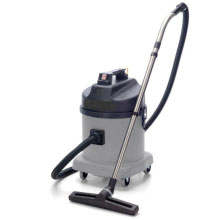All dust collectors, regardless of the model or design, depend on a vacuum to remove the dust from the point of origin. Because of this, it is important to know how to evaluate different vacuums.
There are three important things to look for in a vacuum: CFM, static lift and filtration.
CFM
CFM is an abbreviation for cubic feet per minute. This is a measure of the volume of air the vacuum is moving. Most vacuums move enough air to work with point of origin dust collectors…at least for a few minutes. But on weak vacuums, when the filters start to load up, the CFM begins to drop.
Static Lift
Whereas CFM measures the volume of air moved, static lift measures the ability to keep the air moving under a load. Static lift is measured in inches. It can be equated to torque on a motor. If a vacuum has 80” of lift, it means it can lift a column of water 80” off the ground.
When a filter is loaded up with fine dust, it becomes more difficult to pull air through the pores. A vacuum that delivers 120CFM with 90” of lift will continue to pull a large volume of air through the filter whereas a vacuum that delivers 120CFM with 40” of lift will tend to see a substantial drop in the CFM pulled through the hose. This will result in loss of efficiency for the dust collector.
Filtration
There are many types of good filtration systems. They run from pulse type back flush systems to paper and plastic disposable filters.
The most cost effective systems for the lower priced vacuum systems use a disposable paper or woven plastic filter. They typically hold 5-20 pounds of silica dust. They filter down to .5 microns which is close to the HEPA (High Efficiency Particle Absorbing) spec of .3 microns. When they are full of dust, they are removed from the vacuum and thrown away. They are typically used with a secondary filter that protects the motor and a HEPA downstream filter to remove particles from the exhaust.
Filter systems with poor performance are the pleated filters similar to the air filter on a carburetor or a pleated filter with a flannel bag overcoat. They tend to clog easily, choking down airflow. They are often found on home type garage vacuums that are designed for picking up leaves, dirt and large sawdust. They are generally not suitable for silica, asbestos or fiberglass dust.
In addition to CFM, lift and filtration, the operator should also be aware of how the vacuum is constructed and the true power of the motor.
A bypass motor is always the best design. With this design, the dust is not brought through the motor, thereby prolonging motor life, particularly the brushes and armature. If the vacuum is not equipped with a bypass motor, be sure it has a secondary filter downstream of the disposable filter to further protect the motor in case the disposable bag filter fails.
Lastly, be sure you know how to read the power of the motor. Many vacuums are advertised as 5hp motors. Closer examination will show the fine print to read 5hp at peak power. This is deceptive. All motors draw very high amperage for a few milliseconds upon starting. In almost all cases, the vacuums advertising 5 or 6 hp are actually drawing 30-36 amps on startup after which they settle down to 6 amps. These are really 1 hp motors.
Horsepower in an electric motor is rated at 1hp per 6 amps. If a 110/120V motor draws 12 amps continuously, it is a true 2hp motor.
What is needed to run Dust Collection Products dust collectors?
The Dust Muzzles, Crack Chasers and Saw Muzzle (for the 7” worm drive saws) will be very efficient if they have a steady 80 CFM of airflow through the exhaust port. This airflow can be well maintained if the vacuum has at least 80” of static lift.
The Saw Muzzle GP for the gas-powered saws runs best with a steady 110 CFM and at least 80” of static lift.
A solid vacuum would have these specs:
- 1.8 hp (11 amps)
- Disposable filter and backup filter
- 80” static lift
- 120 CFM
The Nacecare Model 570 is a very strong, industrial vacuum that is capable of running all the Dust Collection products including the Saw Muzzle for Gas-Powered saws at over 95% efficiency.
Features and Specs
- HEPA certified
- 2 year Manufacturers Warranty
- Excellent for silica dust, fiberglass, drywall dust, anti-fouling paint and other toxic contaminates
- 100″ of Lift
- 95 cfm Airflow
- Triple Filter System
- 42′ Power Cord
- Filter Efficiency 99.97% @ .3 Microns
- Wet/Dry filters Available
- Micro Pre-Filters Hold up to 20 Pounds of Dust
- Lightweight
- Quiet: 64db
- 1200 watts, 120VAC/10 Amps
- The Nacecare HEPA Vacuum comes with 10′ of heavy-duty hose, a 3 piece floor wand and a 12″ multi-surface nozzle.

